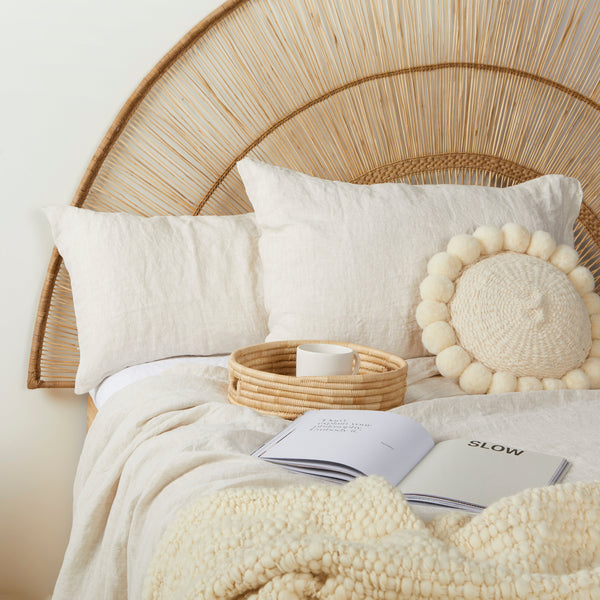Linen - The sustainable natural fabric and its advantages
09/09/2022
Linen fabric is the oldest of all fabrics and has been produced from the flax plant for over 6,000 years. In history, the elaborate and laborious cultivation and production of the fabric have left their mark in the form of idioms. Today, when people talk about flax, they talk a lot of nonsense, which can sometimes break their patience. The 'trip into the blue', with which we venture a journey into the uncertain distance, could have its origins in the blue flowering flax fields that used to line the roads.
But not only in past times, the high quality and beneficial properties of the fabric were appreciated. In recent years, linen is making a comeback - and with good reason.
We will show you the positive properties of linen and the areas of life in which it is particularly popular. Also learn how the robust natural material is obtained and manufactured.
Linen - properties and characteristics
The natural fabric is becoming more and more popular in recent years, but why actually? Linen brings many advantages with it, with which synthetic and also other natural fabrics cannot score.

Fascinating fact: each delicate flax flower sees the light of day for only one morning.
Linen and sustainability
One of them is the resource-saving production of the material. The flax plant thrives under various conditions in all temperate climates. Here, rain is sufficient to supply the plant with water and no additional irrigation is needed.
Moreover, cultivation requires little energy and no pesticides, and generates almost no waste. This is due to the versatile use of the flax plant: its fibers are used to produce the material for linen, while rich oil is extracted from the seeds. On the one hand, this is used for paints or floor coverings, and on the other hand, it is used to produce healthy cooking oil that provides us with omega-3 fatty acids.
Longevity of linen
Another advantage that ensures the sustainability of the fabric is its high quality. Linen consists of robust fibers and is up to 30% more resistant than cotton and up to 10x more durable. The material is better resistant to tears and stretches much less quickly. Due to its resilience, it also proves easy to care for. Linen can be washed at low temperatures in the washing machine. However, bleach should not be allowed to touch the fabric, because it weakens the robust fibers.
If a good piece of linen is treated and cared for properly, then it can be passed down from generation to generation and last for many decades, sometimes even over a hundred years. Thus, linen not only proves to be a highly sustainable and, in the long run, cost-effective investment, but can also tell its own story as an heirloom.
At the same time, linen behaves like a precious wine - it gets better with years. Fresh linen after production is crisp and rigid compared to other natural fibers. However, over time, with use and repeated washing, linen becomes a pleasantly supple and soft fabric.
Comfort and skin friendliness
Fresh in summer and warming in winter - This is how the material is often described, but why is that? Linen is breathable and can absorb up to 20% of its own weight in moisture before the material feels wet. If you sweat in the summer, the fabric wicks the moisture away from your body and then allows it to evaporate. This keeps the skin dry in summer and the fabric unfolds its cooling effect. In winter, the material stores its own body heat and ensures pleasantly warm nights.
Since linen quickly releases the absorbed moisture, no bacteria or other allergens collect in the fibers. The fabric is therefore ideal for allergy sufferers and people with sensitive skin. Moreover, linen is antistatic. This means that the natural fabric does not become electrically charged, as is often the case with synthetic fabrics.
What is made from linen?
These special properties make linen suitable for a wide range of applications. Especially in summer, clothing such as blouses and light pants can provide cooling. Due to the fact that the material is breathable, it is also ideal for bedding, pillowcases and blankets. In summer, linen bedding can bring cooling to hot summer nights. In winter, a particularly tightly woven linen bedding has a warming effect and can help against the dreaded cold feet while sleeping.
Not only its heat-regulating and breathable properties make linen a popular fabric for both clothing and home textiles. Because of its crinkly appearance, linen is often used for decorative purposes as well, as it is precisely this feature that makes up part of its beauty. Here, linen fits perfectly into concepts such as slow living or wabi-sabi, where imperfection, imperfection and naturalness are celebrated and appreciated.

Dried and bundled flax
How is linen obtained?
During flax extraction, the fruit capsules of the flax plant are first removed - the flax seeds for the next seed are hidden in them. In the 'panting' process, the woody fibers of the remaining plant are now pulled through metal brushes several times. The fibers are then bundled and processed into flax, which is then spun into yarn. Finally, linen is woven from this carefully produced yarn.
While linen used to be produced entirely by hand in elaborate processes, today this is only the case with individual handicrafts.
Today, linen is woven by machine. However, even with machine production, the production remains a laborious process. As end products, the fabrics are either left in their natural rough state or washed with stones or in certain drums to make the fabric softer and more supple.
After that, the fabric can still be dyed. Especially in natural tones, such as brown, beige, gray or cream, the material looks both elegant and natural in interior design. A special type of fabric is chambray linen, in which the warp and weft threads have different colors. The warp thread is often white, while the weft can be a thread of any other color. The production here is more complex, but in return the fabric has a wonderful two-tone effect.
Arguably some of the best linen in the world is produced in the Norte region of Portugal. Here, in the center of linen processing in Portugal, near the ancient city of Guimarães, traditional, medium-sized family businesses produce the highest quality linen.

Linen creates a natural, relaxed atmosphere
Create a natural atmosphere with linen
Linen, with its impressive practical as well as visual features, shows us that we are well equipped with natural materials in our home. It is not for nothing that the fabric has been established for thousands of years and has even coined idioms. Its longevity and careful creation process stand for sustainability in our otherwise mass-consumption-driven society. Thus, linen creates an atmosphere of slow living, where we surround ourselves with natural beauty, and take a step towards more conscious living.



